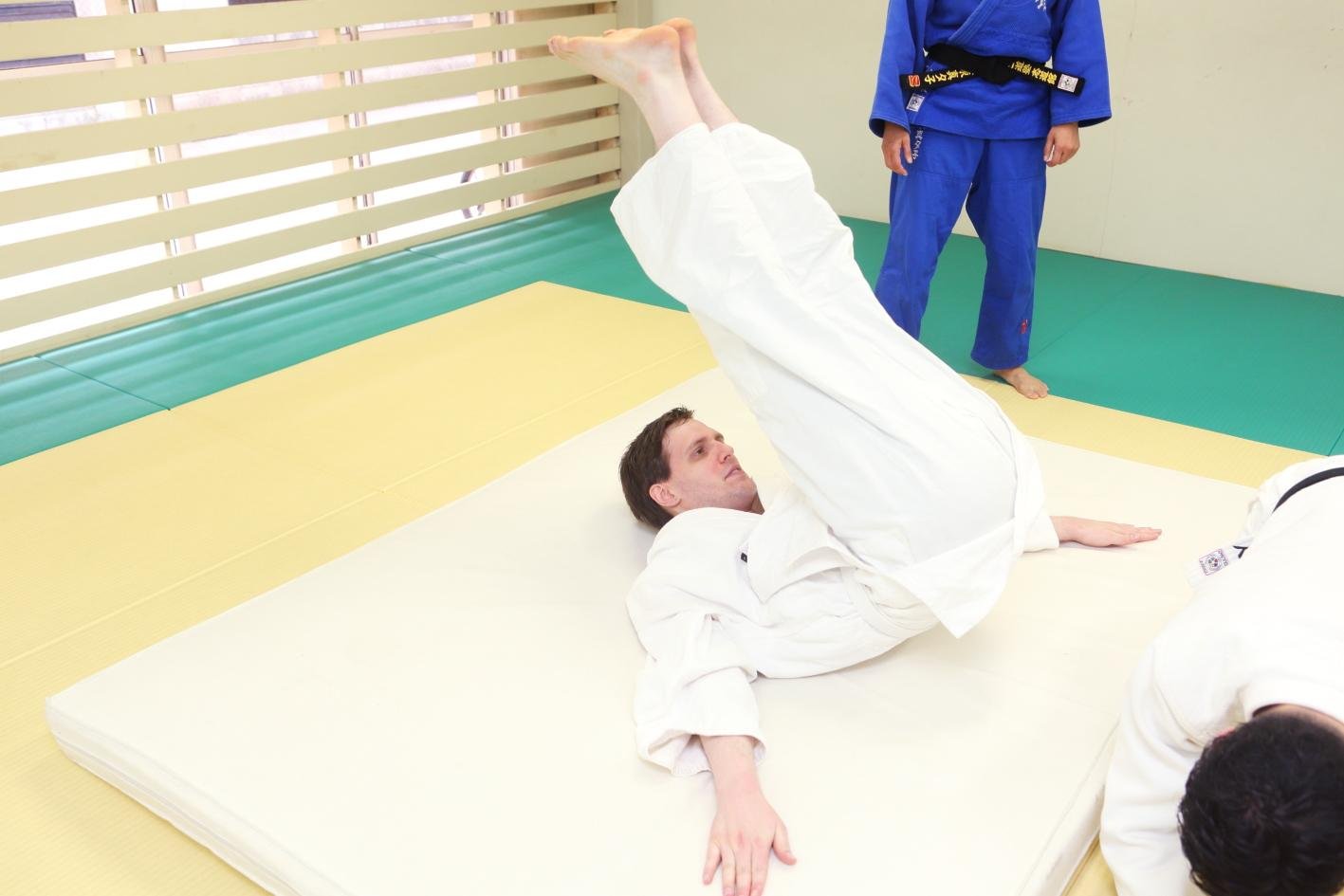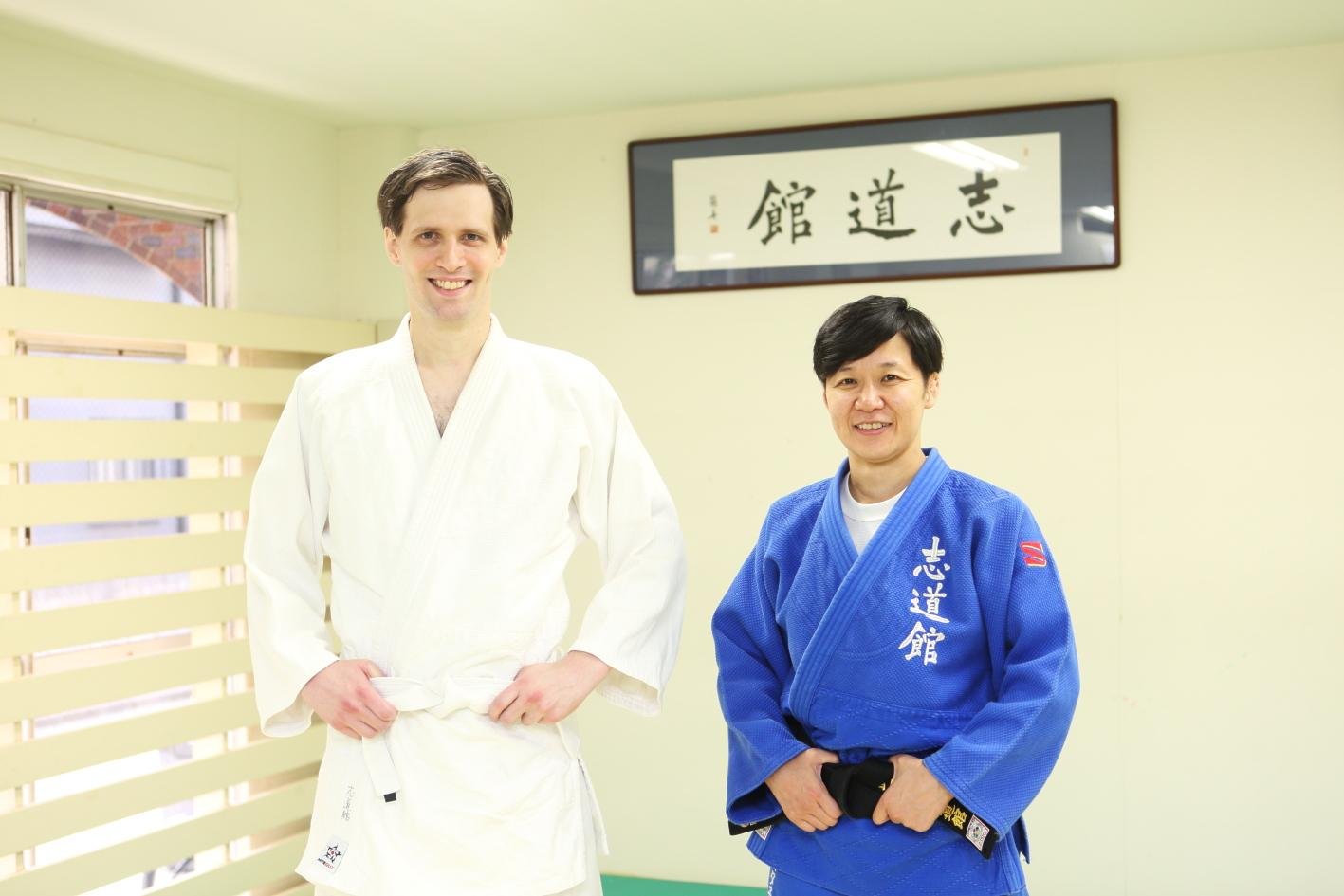Swedish rakugo performer Sanyutei Kouseinen's first-hand experience of budo, Japanese martial arts, in Tokyo. As a unique activity that is part of Japan's sporting culture, budo cultivates the character of practitioners by training both their mind and body. In this series, Kouseinen takes on the challenge of judo, a sport that is also an event at the Olympic Games.
Rakugo
Rakugo is a traditional Japanese narrative art that was first recognized during the Edo period and has been handed down to the present. One distinctive feature of rakugo is the use of ochi (witty puns or punch lines) at the end of the monologue. Rakugo performers rely only on their body movements and hand gestures (as well as small props, such as fans or hand towels, in some instances) when telling the story, and they perform multiple roles by themselves. The boundless world depicted by this traditional Japanese performing art expands with the performer's verbal prowess and the audience's imagination.
What is budo?
Sanyutei Kouseinen is a Swedish rakugo performer who had majored in Japanese at Stockholm University before studying at a university in Japan under a study abroad program in 2012. After enrolling in the Japanese university, he attended a rakugo performance organized for new students and was so fascinated by it that he decided to join the rakugo club. He became immersed in the world of rakugo in no time and joined the Sanyutei rakugo family as an apprentice. After undergoing four years of rigorous training as a zenza (the lowest rank for rakugo performers), Kouseinen was finally promoted to the rank of futatsume (the second highest rank) in 2020, which was an exceptional career achievement for him.
Practicing and training are essential for those involved in both rakugo and budo to become full-fledged performers and practitioners, respectively. As someone deeply steeped in Japan's cultural tradition, Kouseinen decided to take the plunge and experience the traditional sport of judo first-hand.
Many people who have seen judo and karate in movies may still wonder what budo actually refers to. In fact, some Japanese people simply regard budo as any sport in which the winner is decided in a bout. However, budo as it was conceived in Japan in the past is different in certain aspects from regular sports and martial arts. To learn more about the practice of budo today, Kouseinen paid a visit to Shidokan, a judo dojo (a place in which judo and other martial arts are practiced) located in Shinjuku, which is located right in the middle of Tokyo's 23 wards. Mayuko Bando is the director of Shidokan, where students can not only learn judo, but also brush up on their judo etiquette, scholarly knowledge, and English, in line with the dojo's mantra of Bunbu-ichido ("harmonizing cultural scholarship and martial arts").
Upon first entering the dojo, Kouseinen asked, "Who is that person in the black-and-white photo over there?" Director Bando explained that the person in the photo was Kano Jigoro, the founder of judo. "Kano-sensei taught us that the ultimate goal of practicing judo is to train both our body and mind and cultivate our character, so that we can contribute to society. However, it is also true that some dojos these days have been set up with the aim of training athletes for the Olympics, and they are obsessed with winning and losing," Bando pointed out.
Budo practitioners are required to pay respect to their opponents before training commences. This can be done in two different ways, zarei (seated bow) or ritsurei (standing bow). Kouseinen began by learning zarei. For this, the judoka (judo practitioner) shifts his/her left leg backwards from an upright posture and lowers his/her left knee to where the left leg was previously. Next, the right leg is also shifted backwards, and the right knee lowered to where the right leg was. The big toes of both feet are then placed over each other to form the seiza (proper sitting) kneeling position.
This is followed by a brief moment of mokuso (meditation), before three bows are taken for Kano Jigoro-sensei, the instructor, and the opponent, respectively. Each bow lasts around four seconds. The judoka then slides his/her hands down from his/her thighs until they touch the floor, keeps both hands around six centimeters apart, and forms a triangular shape with them during the bow. The bow is maintained for three seconds before the judoka quickly rises and reverts to his/her original position in one second. We were told that the rationale for prescribing such detailed steps is not only to pay respect to one's instructor and seniors, but also to foster empathy and care for one's training opponent so as to prevent injuries to them. Moreover, the practice of paying respect to one's opponent prior to training can minimize the chances of conflicts occurring during a training match.

Practicing the ukemi falling technique to protect both the judoka and the opponent
Next, Kouseinen learned how to perform the ukemi (receival) falling technique. This technique is extremely important in judo as it serves to protect the judoka's body when he/she is being thrown to the ground by the opponent. To perform this technique, the judoka does a low squat from a standing position, tucks in his/her chin and roll backwards, making sure to hit the tatami mat with his/her hands as soon as the belt on the back touches the mat. Both arms are to be raised to a sufficient height and swung down with vigorous force during the roll. It is imperative to practice the ukemi technique diligently to protect one's head when practicing judo. In recent years, judo as a sport has placed greater emphasis than before on preventing injury to both the judoka and the opponent.
The idea of protecting not just yourself, but your opponent as well, is a core principle of judo. It is also this principle that sets judo apart and makes it vastly different from other martial arts.

It's time to try o-goshi!
Finally, Kouseinen gave o-goshi (large hip throw) a go. Judo consists of three fundamental technical elements: kuzushi (breaking the opponent's balance), tsukuri (entering and preparing the throw), and kake (executing the throw). Kuzushi forces the opponent to change his/her stance to make them easier to throw. To do this, the judoka grabs the opponent's lapel with his/her right hand and the sleeve with the left hand before pulling the opponent forward. This is followed by tsukuri, where the judoka takes a step towards the opponent with his/her right foot while maintaining contact, before shifting the center of gravity onto the right leg and rotating the body to the right to line the hip against the opponent's front.
The judoka then uses both hands to control the opponent - one holding the opponent's lapel and the other holding the sleeve - and hits the opponent using their hips and executes the throw, the final step known as kake. At this point, it is vital not to let go of the opponent's sleeve even after performing the throw. By keeping his/her grip on the opponent's sleeve, the judoka can prevent injury to the opponent. This is in line with judo's philosophy of fostering empathy for one's opponent and caring for their well-being.
Although shifting the center of gravity onto the right leg and rotating his/her body might make it seem as if the judoka is dancing, the ability to grasp the right timing from the opponent's breathing is important in judo. As Bando explained, "Timing your movements vis-à-vis your opponent's is such a crucial aspect of judo that the smallest maai (interval) can make all the difference. The more of the opponent's lapel you are grabbing, the closer you are to him/her." Kouseinen responded by saying that he was finally able to appreciate how, at its core, judo is truly about feeling your opponent's breath while picking the right time to apply the technique.
Kouseinen reflected on the importance of judo etiquette after his training session. "It is also basic etiquette in the world of rakugo for the performers to bow to their teacher and the audience. I learned something new today when I discovered the value budo places on this gesture of paying respect as well. In rakugo, too, this is a way of expressing our gratitude and a means of saying, 'Thank you for teaching me what you know.' Rakugo apprentices have tremendous respect for their teachers. My teacher still displays a photo of his late teacher in his room and visits his grave regularly. I don't think he will ever forget his gratitude towards his teacher. When I saw the photo of Kano-sensei in Shidokan, I was struck by how the importance of respecting one's founder and predecessors is shared by both judo and rakugo. It is also necessary for rakugo performers like me to maintain the required distance from the audience. I hope I can apply the idea of ma-ai that I have just learned to rakugo as well."

Sanyutei Kouseinen
Sanyutei Kouseinen is a futatsume-ranked rakugo performer. After graduating from Stockholm University in Sweden, he studied abroad at Chuo University, where he became fascinated by rakugo and joined the rakugo club. Inspired by his passion for rakugo to become a rakugo performer, he joined the Sanyutei rakugo family as an apprentice in 2016. After undergoing four years of training as a zenza, Kouseinen was promoted to the rank of futatsume in August 2020, upon which he received the stage name of Sanyutei Kouseinen from his teacher Koraku to become the first Swedish professional rakugo performer.
- External Link
- https://www.tokyoupdates.metro.tokyo.lg.jp/en/
 Take our user survey and make your voice heard.
Take our user survey and make your voice heard.















3 Comments
Login to comment
James Hendershot
"The idea of protecting not just yourself, but your opponent as well, is a core principle of judo. It is also this principle that sets judo apart and makes it vastly different from other martial arts"
This is an example of Japanese exceptionalism that distracts more than endears. Most people with a background in any of the grappling styles will tell you that there is no intent to harm one's opponent. Modern judo is mostly sport judo, in which the rules of the game dictate the actions, movements, and techniques. Simply put, a sport with fewer rules will by nature have more variability in actions, movements, and techniques. Modern sport judo is plagued by too many rules, not enough freedom of movement, and a scoring system that's overly dogmatic. With that said, to have a well-balanced grappling game, judo is a piece of the puzzle but just a piece.
Jacobo
In my 30 years of practising judo I never felt that it was plagued by too many rules.